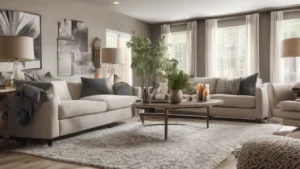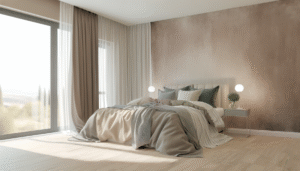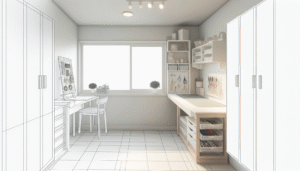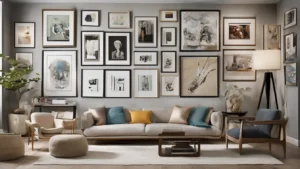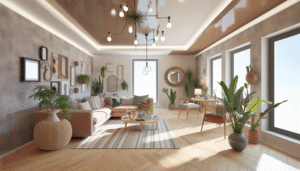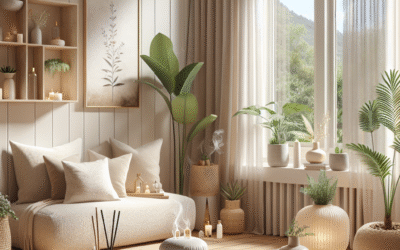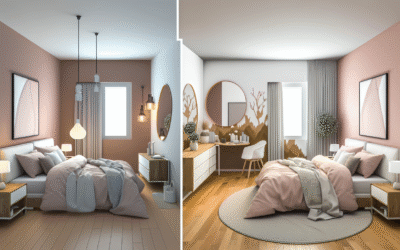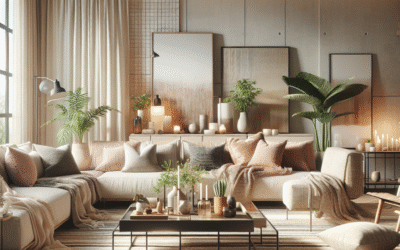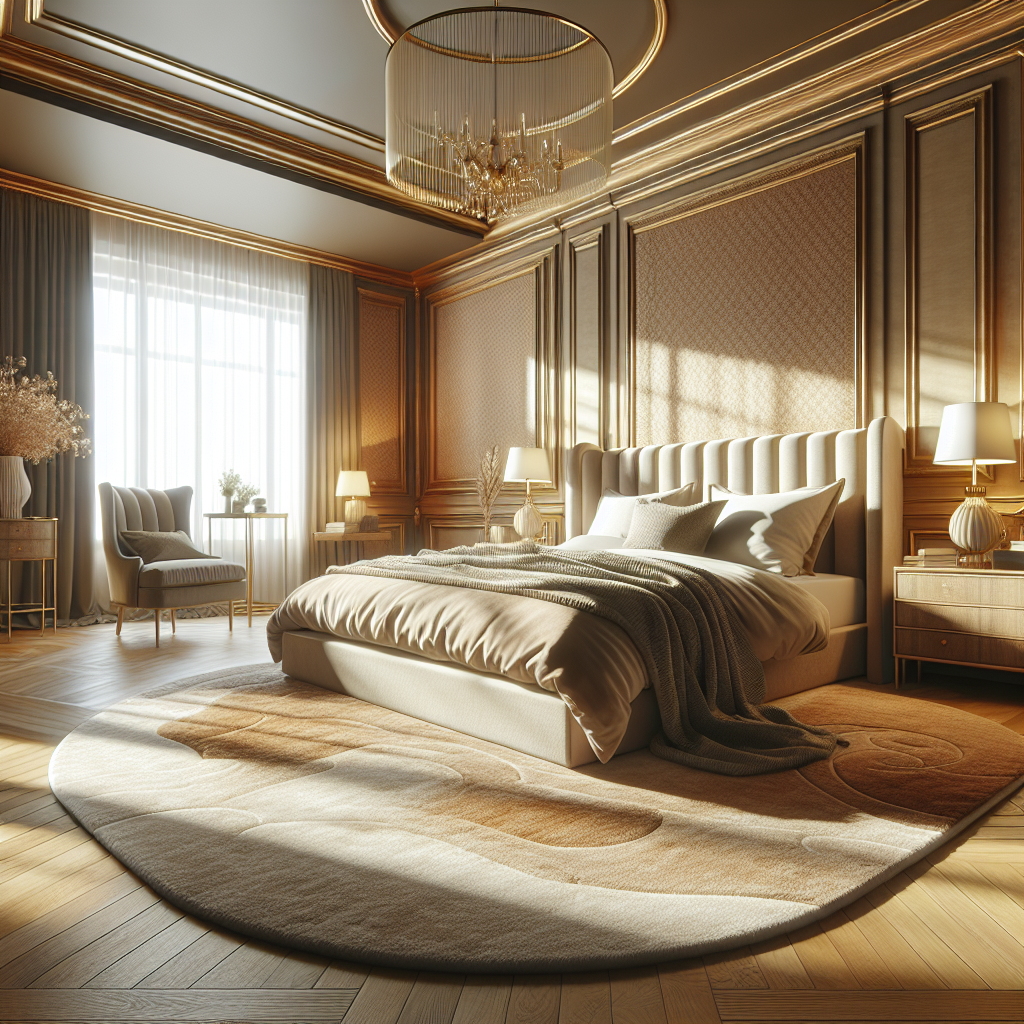
Picture this: you’ve just invested in a beautiful area rug for your bedroom, positioned it carefully under your king bed, and stepped back to admire your handiwork—only to realize something looks off. The rug seems to disappear beneath your massive bed frame, creating an awkward, unbalanced look that makes your entire room feel smaller.
You’re not alone in this frustration. Choosing the right rug size for a king bed ranks among the most common interior design challenges homeowners face. A recent survey by the American Home Furnishings Alliance revealed that 68% of people admit to buying rugs that were too small for their bedroom space, with king bed owners representing the largest segment of sizing mistakes.
The consequences extend beyond aesthetics. An incorrectly sized rug can make even the most expensive bedroom furniture look cheap, disrupt the room’s flow, and create a choppy visual experience that defeats the purpose of adding a rug in the first place. But here’s the good news: with the right measurements and design principles, you can transform your bedroom into a cohesive, luxurious retreat that feels both spacious and intimate.
In this comprehensive guide, we’ll explore the exact dimensions you need for king bed rugs, reveal the most common sizing mistakes that even professional decorators sometimes make, and provide you with a foolproof formula for selecting the perfect rug every time. Whether you’re working with a compact master bedroom or a sprawling suite, you’ll discover actionable strategies that ensure your rug enhances rather than detracts from your room’s design.
Understanding King Bed Dimensions and Spatial Requirements
Before diving into rug specifications, let’s establish the foundation: king beds aren’t all created equal. The standard king bed measures 76 inches wide by 80 inches long, but this measurement only tells part of the story when planning your rug layout.
King Bed Variations and Their Impact
California king beds, popular in Western states, stretch longer but narrower at 72 inches wide by 84 inches long. This four-inch difference in width significantly affects rug placement and visual balance. Split king beds, essentially two twin XL mattresses side by side, measure the same as standard kings but often require special consideration for rug positioning due to the visible mattress separation.
Your bed frame adds crucial dimensions that many people overlook. Platform beds typically extend 2-4 inches beyond the mattress on all sides, while traditional bed frames might add 1-2 inches. Ornate headboards and footboards can introduce additional spatial considerations, especially when determining how much rug should extend beyond the bed’s actual footprint.
The Psychology of Bedroom Space
Bedrooms serve as personal sanctuaries where proportions affect both comfort and sleep quality. Research from the Interior Design Society shows that properly sized rugs contribute to better sleep by creating defined zones and reducing visual chaos. When a rug appears too small, it creates what designers call “floating furniture syndrome”—where pieces seem disconnected from their environment.
Consider the traffic patterns around your king bed. Most people need at least 24-30 inches of walking space on either side of the bed, with 36 inches being ideal for shared bedrooms. These clearances directly influence your optimal rug size and positioning strategy.
The Golden Rules for King Bed Rug Sizing
Professional interior designers follow specific formulas when sizing rugs for king beds, and understanding these principles eliminates guesswork from your selection process.
The 8×10 Standard: When It Works and When It Doesn’t
The ubiquitous 8×10 rug represents the most commonly purchased size for king bedrooms, but it’s not automatically the right choice. An 8×10 rug works beautifully when positioned entirely under the bed with 12-18 inches extending beyond the foot and sides. This creates what designers call the “full coverage” look—sophisticated and hotel-like.
However, 8×10 rugs fail in rooms where you want significant rug exposure around the bed perimeter. If your goal includes substantial rug borders for walking areas, you’ll need to size up significantly.
The 9×12 Sweet Spot
For most king bed installations, 9×12 rugs provide the ideal balance of coverage and proportion. This size allows for 18-24 inches of rug extension beyond the bed on three sides while maintaining visual cohesion. The extra square footage prevents the common “postage stamp” effect where rugs look overwhelmed by large furniture pieces.
A 9×12 rug accommodates bedside tables while ensuring guests step onto soft flooring when exiting the bed—a luxury detail that elevates the entire bedroom experience.
Super-Sizing: When to Choose 10×14 or Larger
Rooms exceeding 14×16 feet often benefit from 10×14 rugs or larger custom sizes. These generous proportions work especially well in luxury hotel suites and master bedrooms where the rug serves multiple zones beyond just the sleeping area.
Large rugs enable creative furniture arrangements, such as positioning reading chairs or benches entirely on the rug perimeter, creating intimate conversation areas within the bedroom space.
Room Size Calculations: Matching Rugs to Your Space
Your bedroom’s dimensions dictate appropriate rug sizing more than any other factor. Let’s break down the mathematics that ensure perfect proportional relationships.
Small to Medium Bedrooms (10×12 to 12×14 feet)
Compact bedrooms require strategic rug placement to maximize visual space. In rooms measuring 10×12 feet, position your king bed against the longest wall with a 6×9 or 8×10 rug placed partially under the bed. The rug should extend 18-24 inches beyond the foot of the bed while the head remains on bare flooring.
This “two-thirds rule” creates the illusion of larger floor space while providing practical benefits. Your feet contact soft flooring when getting out of bed, but the room doesn’t feel overwhelmed by textile coverage.
For 12×14 rooms, 8×10 rugs work beautifully when centered under the bed with equal extensions on both sides and the foot. This symmetrical approach creates balance while leaving defined borders of exposed flooring that make the room feel larger than its actual dimensions.
Large Bedrooms (14×16 feet and up)
Spacious bedrooms offer flexibility for dramatic rug statements. In 14×16 rooms, 9×12 rugs provide excellent proportion when fully centered under the king bed with substantial perimeter exposure. The generous sizing allows bedside tables to sit partially or completely on the rug, creating cohesive furniture groupings.
For rooms exceeding 16×18 feet, consider 10×14 or 12×15 rugs that accommodate additional furniture pieces like armchairs, ottomans, or vanity areas. These super-sized rugs transform bedrooms into multi-functional suites while maintaining visual unity.
Awkward Room Shapes and Solutions
Long, narrow bedrooms require modified approaches to standard sizing guidelines. In rooms measuring 12×20 feet, position the king bed along the shorter wall with an 8×10 rug extending primarily toward the room’s center. This draws attention away from the narrow proportions while creating better traffic flow.
Square bedrooms often benefit from round rugs, particularly rooms measuring 14×14 feet or similar. A 10-foot round rug under a king bed creates sophisticated geometry that softens the room’s angular nature while providing adequate coverage.
Rug Placement Strategies That Transform Your Bedroom
Beyond size selection, strategic placement determines whether your rug enhances or detracts from your bedroom’s overall design. The following techniques ensure professional-quality results regardless of your room’s specific challenges.
The Full-Under Placement Method
Positioning your entire king bed on the rug creates a luxurious, hotel-inspired aesthetic that works particularly well in formal bedrooms. This technique requires 9×12 rugs at minimum, with 10×14 sizes providing more generous borders.
For full-under placement, center the rug precisely beneath the bed with equal extensions on three sides. The headboard may extend beyond the rug’s edge—this actually creates visual interest and prevents the rug from disappearing entirely under furniture.
Benefits of full-under placement include unified furniture groupings, easy cleaning (the rug protects flooring from bed scratches), and immediate luxury appeal that rivals expensive resorts.
The Two-Thirds Strategy
This professional technique involves placing approximately two-thirds of the bed on the rug while leaving the head area on bare flooring. The method works excellently with 8×10 rugs in medium-sized bedrooms and creates dynamic visual interest through mixed textures.
Position the rug so it extends 6-8 inches beyond each side of the bed and 18-24 inches beyond the foot. This ensures anyone sitting on the bed’s edge contacts the rug while maintaining proportional balance with exposed flooring.
The two-thirds approach works especially well when you want to highlight beautiful hardwood or tile flooring while still enjoying the comfort and style benefits of area rugs.
Side-Placement Techniques for Asymmetrical Rooms
Bedrooms with challenging layouts—such as slanted walls, prominent fireplaces, or large windows—sometimes require innovative rug placement. Consider positioning a 6×9 or 8×10 rug along one side of the king bed, creating an asymmetrical but intentionally designed focal point.
This technique works particularly well when one side of the bed faces a seating area or serves as the primary exit route. The rug defines that zone while leaving the opposite side open for different flooring treatments or smaller accent rugs.
Common King Bed Rug Sizing Mistakes and How to Avoid Them
Even experienced decorators occasionally make rug sizing errors that compromise their bedroom designs. Learning from these common mistakes saves time, money, and frustration while ensuring your first choice delivers lasting satisfaction.
The “Floating Island” Effect
Perhaps the most frequent mistake involves choosing rugs that disappear entirely under the king bed, creating what designers call floating island syndrome. This occurs when homeowners select 5×8 or 6×9 rugs for king beds, leaving only small borders visible around the bed’s perimeter.
The floating island effect makes expensive rugs look like afterthoughts while failing to provide practical benefits like comfortable stepping surfaces. Your rug investment essentially becomes invisible, offering neither visual impact nor functional value.
To avoid this trap, ensure at least 18 inches of rug extends beyond your bed on the sides where people typically exit. This minimum exposure creates visual weight while serving practical purposes.
Overshooting with Inappropriate Large Sizes
On the opposite extreme, some homeowners select rugs so large they overwhelm their bedroom’s proportions. A 12×15 rug in a 12×14 room, for example, creates wall-to-wall coverage that eliminates architectural details and makes the space feel smaller despite the rug’s generous dimensions.
Oversized rugs also present practical challenges, including difficult cleaning, higher replacement costs, and limited future flexibility if you rearrange furniture or move to a different home.
The solution involves measuring your room carefully and ensuring at least 18-24 inches of exposed flooring around the rug’s perimeter. This border creates definition and prevents the overwhelming effect that destroys visual balance.
Ignoring Bedside Table Integration
Many people focus solely on bed-to-rug proportions while forgetting how bedside tables affect the overall composition. Nightstands floating awkwardly half-on and half-off rugs create disjointed looks that appear accidental rather than intentional.
When selecting rug sizes, decide whether bedside tables will sit completely on the rug, completely off the rug, or strategically positioned with front legs on and back legs off (which can work with specific furniture styles).
For cohesive integration, choose 9×12 or larger rugs that accommodate nightstands entirely, or select smaller 8×10 rugs positioned so bedside tables sit completely on exposed flooring. Mixed positioning requires careful execution to appear intentional.
Material and Style Considerations for King Bed Rugs
While size represents the most critical factor in king bed rug selection, material and style choices significantly impact both aesthetics and long-term satisfaction. Understanding how different options perform in bedroom environments guides smarter purchasing decisions.
High-Traffic Performance in Bedroom Settings
Bedroom rugs experience different wear patterns than living area pieces, but they still require durability considerations. The foot of the bed typically receives the highest traffic as people sit and stand, making this area prone to premature wear with delicate materials.
Wool rugs offer excellent durability and natural stain resistance, making them ideal for king bed installations where longevity matters. High-quality synthetic materials like polypropylene provide similar performance at lower price points while offering superior stain prevention—crucial for households with pets or young children.
Natural fiber rugs like jute or sisal work beautifully in bedrooms but require careful consideration of texture. Some people find these materials too rough for bare feet, particularly during nighttime trips to the bathroom.
Pile Height and Bedroom Functionality
Low to medium pile heights (0.25 to 0.5 inches) work best for king bed rugs because they prevent furniture from rocking while maintaining easy cleaning access. High-pile rugs create luxurious texture but can interfere with bedroom doors, dresser drawers, and furniture stability.
Consider how your bedroom door swings when evaluating pile height. Rugs that impede door operation create daily frustration that outweighs any aesthetic benefits. Measure the clearance between your door bottom and flooring, then select rugs with appropriate thickness.
Color Psychology in Bedroom Environments
Bedroom color choices affect sleep quality and mood more than any other room, making rug color selection particularly important. Neutral tones like beige, gray, and soft blues create calming environments that promote restful sleep, while bold colors can energize spaces that double as work areas.
Dark colored rugs hide dirt effectively but can make rooms feel smaller, while light colors expand visual space but require more frequent cleaning. Consider your lifestyle and maintenance preferences when balancing aesthetic desires with practical requirements.
Pattern selection follows similar principles—busy patterns can overwhelm bedrooms and interfere with sleep, while subtle geometric or organic designs add visual interest without creating chaos.
Budget-Smart Strategies for King Bed Rug Shopping
Quality rugs in king bed-appropriate sizes represent significant investments, but strategic shopping approaches maximize value while ensuring satisfaction. Understanding where to allocate your budget prevents costly mistakes while securing pieces that enhance your bedroom for years.
Timing Your Purchase for Maximum Value
Rug retailers typically offer substantial discounts during specific seasons, with January through March representing the best buying opportunities. Post-holiday clearances often include floor samples and overstock inventory in desirable sizes like 9×12 and 8×10.
Estate sales and consignment shops frequently feature high-quality vintage and antique rugs at fraction of retail prices. These venues work particularly well for one-of-a-kind pieces that create distinctive bedroom character impossible to achieve with mass-produced options.
Online retailers offer competitive pricing but require careful attention to return policies, especially for large rugs where color and texture representation can vary significantly from screen images. Look for companies offering generous return windows and detailed material descriptions.
Investment Pieces vs. Temporary Solutions
Determine whether your king bed rug represents a long-term investment or short-term solution before establishing your budget. Temporary rentals, starter homes, or experimental design phases often justify less expensive options that provide immediate satisfaction without long-term commitment.
Investment-grade rugs for permanent homes warrant higher budgets focused on materials like hand-knotted wool or vintage pieces that improve with age. These selections often appreciate in value while providing decades of service when properly maintained.
Consider your lifestyle timeline when making this determination. Young professionals expecting multiple relocations might prioritize affordable options, while established homeowners benefit from quality investments that mature alongside their design aesthetic.
Size vs. Quality Trade-offs
Limited budgets often force choices between larger, lower-quality rugs and smaller, premium pieces. For king beds, size generally trumps material quality because incorrect proportions undermine any rug’s effectiveness regardless of construction quality.
A well-sized synthetic rug creates better bedroom aesthetics than a premium wool piece that’s too small. Focus on achieving proper dimensions first, then upgrade material quality when future budgets allow.
Layering represents an creative compromise that achieves large coverage areas affordably. Place a neutral, inexpensive large rug as the foundation layer, then add smaller premium pieces for texture and visual interest.
Professional Installation and Maintenance Tips
Proper installation and ongoing care protect your rug investment while ensuring it continues enhancing your bedroom’s appearance throughout its lifespan. Professional techniques prevent common problems that compromise both aesthetics and durability.
Rug Pad Selection for King Bed Applications
Quality rug pads provide essential benefits including slip prevention, extended rug life, and improved comfort underfoot. For king bed rugs, select pads that measure 2 inches smaller than your rug on all sides—this prevents edges from showing while providing complete coverage where needed.
Dense rubber pads work best for bedroom applications because they prevent furniture from shifting while providing cushioning that makes lower-quality rugs feel more luxurious. Avoid thin foam pads that compress quickly and offer minimal benefits.
In bedrooms with radiant floor heating, choose specialized pads designed for heated surfaces. Standard pads can break down under consistent heat exposure, creating unpleasant odors and reducing effectiveness.
Positioning Techniques for Professional Results
Center your rug precisely by measuring the distance from each wall to ensure equal borders. Use painter’s tape to mark rug corners before final positioning—this prevents multiple adjustments that can damage delicate flooring.
When placing partial-under configurations, align the rug parallel to your bed’s footboard rather than the room’s walls if they’re not perfectly square. Rug-to-furniture alignment matters more than rug-to-architecture alignment for visual satisfaction.
Allow new rugs to acclimate for 24-48 hours before adding furniture weight. This prevents permanent indentations while allowing natural fibers to settle into their final positions.
Long-term Care Strategies
Bedroom rugs require different maintenance approaches than high-traffic area pieces, but neglecting care shortens lifespan and compromises appearance. Vacuum weekly using appropriate brush settings for your rug’s pile height, and rotate the rug every six months to ensure even wear patterns.
Address spills immediately using blotting rather than rubbing techniques that can damage fibers. Keep manufacturer care instructions accessible for reference when professional cleaning becomes necessary.
Professional cleaning every 12-18 months maintains appearance and removes accumulated allergens that can interfere with sleep quality. Schedule cleanings during seasons when you can easily relocate bedroom activities while the rug dries.
Creating Cohesive Design with Your King Bed Rug
A properly sized rug serves as the foundation for cohesive bedroom design, but maximizing its impact requires understanding how it interacts with other design elements. Strategic coordination creates harmonious spaces that feel intentionally designed rather than accidentally assembled.
Color Coordination Strategies
Your king bed rug should either complement or contrast with existing bedroom elements, but avoid matching exactly—perfect matches appear flat and lack visual interest. If your bedding features cool tones, warm rug colors create dynamic tension, while analogous color schemes produce serene, spa-like environments.
Consider the 60-30-10 color rule where your rug contributes to the 60% dominant color, 30% secondary color, or 10% accent color depending on its visual prominence. Large 9×12 or bigger rugs often function as dominant color contributors, while smaller pieces serve accent roles.
Test color combinations using small samples before committing to large purchases. Lighting conditions dramatically affect color appearance, so evaluate options during different times of day when you’ll actually use the bedroom.
Texture and Pattern Integration
Balance smooth surfaces like silk bedding or leather furniture with textured rugs that add tactile interest. Conversely, heavily textured bedrooms benefit from smoother rug surfaces that provide visual rest areas.
When mixing patterns, vary the scale to prevent competition—large geometric bedding pairs beautifully with small geometric or solid rugs, while busy wallpaper benefits from simple, solid-colored floor treatments.
Layer different textures through accessories like throw pillows and blankets that bridge between your rug and other bedroom elements. This creates sophisticated depth without overwhelming the space.
Furniture Arrangement Enhancement
Use your properly sized rug to define furniture groupings and create intentional zones within larger bedrooms. Position reading chairs partially on the rug to integrate them with the sleeping area, or create completely separate conversation areas using rug borders as natural boundaries.
Angle furniture slightly rather than placing everything parallel to walls—this creates more dynamic, interesting arrangements while making better use of your rug’s surface area.
Consider the sight lines from your bed to other room areas. Your rug should guide the eye naturally toward positive focal points while de-emphasizing less attractive elements like radiators or awkward architectural features.
What size rug works best under a king bed?
For most king beds, a 9×12 rug provides optimal proportion and coverage. This size allows 18-24 inches of rug extension beyond the bed on three sides while preventing the “floating furniture” effect. In smaller bedrooms, 8×10 rugs work well when positioned two-thirds under the bed.
Should my entire king bed sit on the rug?
Not necessarily. While full coverage creates a luxurious hotel effect with 9×12 or larger rugs, partial placement can be equally attractive. The “two-thirds rule” places most of the bed on the rug while leaving the headboard area on bare flooring, which works especially well in medium-sized rooms.
How much should a rug extend beyond a king bed?
Aim for 18-24 inches of rug extension beyond the foot of the bed and 12-18 inches on each side. This ensures people step onto the rug when getting out of bed while maintaining proper proportions. Less than 12 inches creates an unbalanced appearance.
Can I use an 8×10 rug with a king bed?
Yes, 8×10 rugs work well for king beds when positioned strategically. Place the rug so it extends primarily beyond the foot of the bed with equal side exposure. This size works best with the partial-under placement method rather than attempting full bed coverage.
What if my bedroom is too small for a large rug?
In compact bedrooms (10×12 feet or smaller), consider a 6×9 rug positioned at the foot of the bed, or use a runner on each side. These alternatives provide comfort and style without overwhelming limited floor space or making the room feel cramped.
Should bedside tables sit on the rug?
This depends on your rug size and design preferences. With 9×12 or larger rugs, nightstands can sit entirely on the rug for integrated groupings. With 8×10 rugs, position nightstands completely off the rug for clean lines, avoiding half-on, half-off placement that appears accidental.
How do I center a rug under my king bed properly?
Measure from each wall to ensure equal borders around the rug perimeter. The bed should be centered on the rug with identical spacing on both sides. Use painter’s tape to mark corners before final placement, and ensure the rug aligns with the bed rather than slightly off-center room walls.
Are round rugs appropriate for king beds?
Round rugs can work beautifully with king beds, especially in square bedrooms. A 10-foot round rug provides adequate coverage while creating interesting geometry. However, rectangular rugs typically offer better proportion and easier furniture integration for most bedroom layouts.
Transform Your Bedroom with Confident Rug Selection
Selecting the perfect rug size for your king bed doesn’t have to feel overwhelming when you understand the foundational principles that guide professional designers. The difference between a bedroom that feels accidentally assembled and one that exudes intentional luxury often comes down to these precise proportional relationships.
Remember that your king bed rug sizing strategy should prioritize function alongside form. A 9×12 rug offers the sweet spot for most installations, providing generous coverage without overwhelming your space. When budget or room constraints require smaller options, 8×10 rugs deliver excellent results with strategic partial-under placement that maintains visual balance.
The investment you make in proper sizing pays dividends far beyond aesthetics. Correctly proportioned rugs improve your daily experience through comfortable stepping surfaces, reduce cleaning time by protecting flooring, and create the foundation for cohesive design that enhances your home’s value.
Take time to measure your space carefully, consider your lifestyle needs, and visualize how different sizing options will function in your specific room. Whether you choose luxurious natural fibers or budget-friendly synthetic materials, getting the dimensions right ensures your selection enhances rather than detracts from your bedroom’s overall appeal.
Start implementing these guidelines today by measuring your current setup and identifying opportunities for improvement. Your bedroom should serve as a personal retreat that welcomes you home each evening—and the right rug size creates exactly that sanctuary feeling you deserve.
—
####
Content Disclaimer
The information provided in this guide is for educational and informational purposes only. Room dimensions, furniture sizes, and design preferences vary significantly between homes and individuals. While these guidelines represent professional best practices, always measure your specific space and consider your personal needs when making rug purchasing decisions. Consult with interior design professionals for complex room layouts or when making significant investments in home furnishings.
Categories
- Accent Walls & Ceilings (61)
- Art Curation & Gallery (62)
- Bedding Style Trends (68)
- Bedroom Makeover (81)
- Bohemian & Eclectic Styles (58)
- DIY & Budget-Friendly Decor (64)
- Eco-Friendly Design (62)
- Furniture Care (71)
- Home Decor & Design Ideas (162)
- Home Wellness Spaces (59)
- Integrated Outdoor Living (67)
- Japandi Style (61)
- Kids and Nursery Decor (59)
- Living Room Decor (79)
- Mix & Match Techniques (73)
- Modern & Contemporary Design (66)
- Rug Sizing & Placement (73)
- Scandinavian Design Inspiration (20)
- Seasonal Home Decor (79)
- Small Space Solutions (73)
- Wall Art & Painting Tips (77)
Recent Comments
Archives
Product Gallery
-
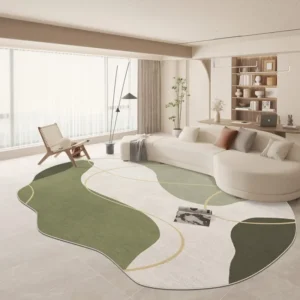 Large Area Green Rugs for Bedroom Nordic Living Room Decoration Shaped Carpet Irregular Plush Lounge Rug Home Thick Washable Mat
Rated 5.00 out of 5$55.01 – $346.86Price range: $55.01 through $346.86
Large Area Green Rugs for Bedroom Nordic Living Room Decoration Shaped Carpet Irregular Plush Lounge Rug Home Thick Washable Mat
Rated 5.00 out of 5$55.01 – $346.86Price range: $55.01 through $346.86 -
 Nordic Style Rugs for Bedroom Morandi Living Room Decoration Carpet Large Area Geometry Lounge Rug Home Cloakroom Non-slip Mat
Rated 5.00 out of 5$39.51 – $598.43Price range: $39.51 through $598.43
Nordic Style Rugs for Bedroom Morandi Living Room Decoration Carpet Large Area Geometry Lounge Rug Home Cloakroom Non-slip Mat
Rated 5.00 out of 5$39.51 – $598.43Price range: $39.51 through $598.43 -
 Irregular Shapes Living Room Decoration Carpet Modern Style Rugs for Bedroom Home Thicken Plush Rug Fluffy Soft Lounge Floor Mat
Rated 4.83 out of 5$55.91 – $347.82Price range: $55.91 through $347.82
Irregular Shapes Living Room Decoration Carpet Modern Style Rugs for Bedroom Home Thicken Plush Rug Fluffy Soft Lounge Floor Mat
Rated 4.83 out of 5$55.91 – $347.82Price range: $55.91 through $347.82

